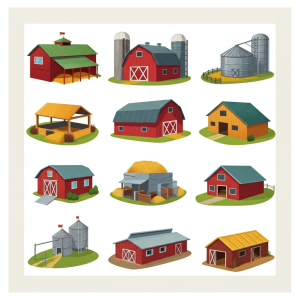Farm structures and buildings are not very fun compared to planting some crops or raising some animals, but they are a vital part of making farming effective and successful. To the JSS2 students, agricultural learning entails knowing farm structures.
This field guide shall bring you through the fundamentals of farm structures and buildings. You will learn their identity, importance, available types and maintenance of adesiccators.
What are Farm Structures and Why Are they Important?
Farm structures are physical structures constructed on farms to facilitate workings of the farm. There is a lot of mixed purposes they can be used such as cattle barns, grain storage, tool handling, and machinery protection (and) shelter against the elements.
What is the importance of farm structures?
-
Livestock Protection: Animals are kept in a good shelter to protect them against the cruel weather and predators.
-
Crop Storage: Crop spoilage of the harvested crops should be avoided, and stability of food supply as well as continuity of income be ensured.
-
Effectiveness: enhances efficiency in farming and saves time and work.
-
Equipment Longevity: It will keep expensive equipment safe against wear and tear as a result of weather factors.

Usual Forms of Farm structures
There are various farm structures which are used in certain functions. We are going to consider their usage and examples below.
1. Livestock housing
By giving animals shelters, they will be healthy and productive.
Poultry Housing:
Raising of chickens is usually done through Deep litter system housing and the battery cage systems.
Piggery:
It consists of specialized places, such as:
-
Farrowing pens (to raise sows)
-
Weaners (young pigens)
-
Grower pens (older pigs)
2. Storage Facilities
Agricultural farmers cannot afford not to preserve food and feed.
Barns:
Both old style barns (built with wood) and steel-framed barns are the best places to store hay, straw and other feeds.
Silos:
Tower silos and bunker silos are utilized in storage of silage.
Grain Stores:
Metal Aerated grain silos and concrete grain bins store grains in a fresh pest free manner.
3. Farm Workshops and Machines Sheds
These preserve tools and equipment keeping it well organized and safe.
Workshops:
These are half open sheds or closed spaces where repairing of tools and equipments are carried out.
Machinery Sheds:
Offer protection to such large machinery as tractors, harvesters, etc.
Material Used in Structures of the Farms
In the construction of farm structures however, selection of materials is very important so as to make them durable and cheap.
Local Materials
-
Examples: Thatch, wood, mud bricks and bamboo.
-
Merits: Low cost and they are easily accessible in the rural settings.
-
Cons: Not durable or long lasting and may not resist extreme weather conditions.
Modern Materials
-
Examples: Cement, concrete, metal (steel, aluminum), plastics.
-
Strengths: Heavy, weather resistant and easy to maintain.
-
Cons: They are in most cases costly to be used than those locally sourced.
Considerations In Place of Building Structures on the Farm
To have good effectiveness and cost-efficiency in farm structure before you start constructing it, take into consideration the following factors.
Purpose
The structure should be designed in a manner that it performs a particular purpose like storing crops or housing animals.
Cost
Select those materials and the design that would suit the budget without reducing the quality.
Durability
Choose durable material which can handle weather and wear and tear, on long term investments.
Environmental Conditions
Consider weather conditions such as rain, heat or wind in your design. An example is the farm shed in a rainy region is supposed to be having a slanted roof so that there is no pool of rainwater marked.
Space Efficiency
The size should also be optimized so as not to have overcrowding in the house of livestock or misutilizing the storage space.
Farmstructures, How to Maintain
The preservation of the farm structures is important to prolong existence and performance. Deteriorated structure may cause loses in animals, crops and machinery.
Maintenance Steps
Regular Inspections
Establish regular inspection to grow the small problems such as water leakages, crack or infestation of pests.
Pest Control
Make storage places free of pests to prevent crop destruction. Where possible, use traps, natural control or storage materials that are resistant to pests.
Weatherproofing
Assure the structures against weather changes by fixing roofs, treating wooden parts against termites and sealing any hole.
Prompt Repairs
Repair damages on time before they compound and turn out to be expensive in the future.
The significance of Farm Structures in farming.
The farming buildings do not only refer to physical buildings but are the foundation to successful, profitable farming. On livestock these structures give protection and comfort. To crops and equipment they guarantee endurance and security. Such benefits play positively toward overall success of any farming operation regardless of size.
At JSS2 level, knowing the fundamentals of farm buildings will enable the students to know how much considerations and work will be put into constructing a fruitful farm. Perhaps one never knows. This knowledge maybe that can inspire some to become a developer of the future of agriculture!

2 comments
7xisa5
naie8j